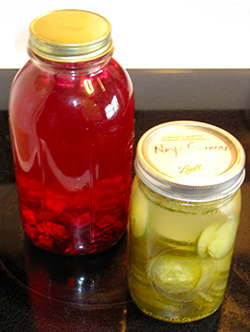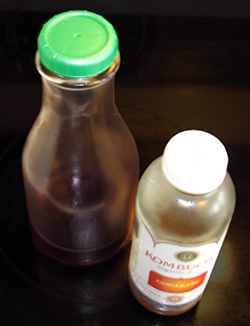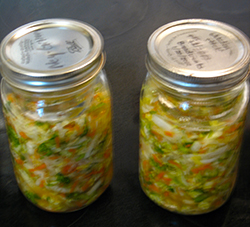I found myself thinking a lot about food in the aftermath of my latest oral surgery.
 Beet kvass preoccupied me first.
Beet kvass preoccupied me first.
What is beet kvass?
It’s a lacto-fermented beverage made from beets. Lacto-fermentation is the process whereby milk is turned into yogurt. But you can lacto-ferment many other foods besides milk. Lacto-fermentation makes foods more digestible, preserves them from spoilage, and makes the vitamins and minerals in them much more bio-available.
I first discovered beet kvass several years ago, and I loved the taste.
I’d lapsed in making it, but decided that it would be especially good for me in the aftermath of surgery.
I made a point of drinking beet kvass after my May surgery.
After my August surgery, I was unable to drink anything for the first several days. When I became able to swallow, I dove for the beet kvass. Not only did it taste good, but it felt as though each mouthful was an elixir from a magical healing spring.
I couldn’t help thinking about the progression of my healing and beet kvass.
The May surgery was on a Wednesday, and when my surgeon saw me 5 days later on Monday, he expressed surprise at how good my mouth looked. He said he had expected everything to be much more swollen. Instead, the swelling was minimal.
My August surgery was on a Thursday. Because of the surgical and post-surgical complications, my surgeon saw me on Friday, Saturday, and Sunday, when my mouth was looking very poor indeed. When he saw me that Monday (4 days after the surgery), he actually winced, because it still looked so bad.
But a week later, he repeated what he’d said at the May surgery: that he was surprised at how good my mouth looked.
 I am convinced it was the beet kvass.
I am convinced it was the beet kvass.
Of course, there is no proof. My experience is purely anecdotal. But in my heart of hearts, I’m convinced.
(You can read more about beet kvass in this blog post.)
My post-surgery beet kvass experience led to further thoughts about food.
I watched an episode of The Paleo Way on Netflix. I re-read Nourishing Traditions from cover to cover. I started a list of recipes I wanted to try once I was recovered enough to cook (and to eat things other than liquids).
At first I explained my pre-occupation with food as the natural re-assessment of life one might do after a crisis. What are my priorities? Should I be doing something different? How do I want to go forward once I’m well again?
That was one facet of it.
But while chatting with my daughter I discovered that she, too, had been focused on food in the aftermath of having all four of her wisdom teeth out in June. She’d watched cooking shows non-stop.
We both realized that when you are on a liquid diet, you get so hungry!
So, yes, I was re-assessing as one does. But my re-assessment was probably focused on food because I was hungry. 😀
What results did my re-assessing deliver?
I was reminded of something a friend of mine said to me a couple years ago. She realized she was good at avoiding foods that were bad for her, but that she needed to put more effort toward seeking out foods that were especially good for her.
That was my own conclusion for myself.
I avoid processed foods, seed oils, sugar, grains, and legumes. But I’m not getting enough of the nutrient-dense foods that promote well-being and vibrant health. I made a list.
1) I need more healthy fats in my diet.
 Saturated fats provide the building blocks for the cell membrane of every cell in my body and the building blocks for most of the hormones and hormone-like workhorses in my body. And fats alone permit the assimilation of the fat-soluble vitamins.
Saturated fats provide the building blocks for the cell membrane of every cell in my body and the building blocks for most of the hormones and hormone-like workhorses in my body. And fats alone permit the assimilation of the fat-soluble vitamins.
My husband has been doing more of the cooking lately, and he simply does not use as much butter as I do. Nor does he make sauces. Of course, I’d not created as many sauces as would be ideal, when I was doing more of the cooking. But this was something I could improve on.
I hope to create homemade mayonnaise regularly. To drizzle butter over baked vegetables. To dive into the world of sauces and make them a regular part of my cooking repertoire. (I’ve made two batches of mayo so far.)
2) I need to ingest bone broth nearly every day.
 Bone broth heals the intestinal wall, makes vitamins and minerals more readily assimilable, and provides a catalyst affect for stronger bones.
Bone broth heals the intestinal wall, makes vitamins and minerals more readily assimilable, and provides a catalyst affect for stronger bones.
I don’t know what I was thinking in not drinking bone broth regularly for the last few years. The instant I was diagnosed with osteopenia (and then osteoporosis), I should have been on the bone broth wagon.
Actually, I think I did start off with that intention, but I somehow lost track of it.
It is time to get serious about bone broth. I’ve made two big pots of it during my convalescence, and I hope to continue indefinitely. Not only will I drink the broth plain, but I’ll make soups with it. It serves as the basis for many sauces as well.
3) I need to eat lacto-fermented foods every day.
 Lacto-fermented foods have live enzymes in them that supplement the digestive enzymes made by the body. Additionally, they produce lactic acid, which encourages the growth of the symbiotic flora that humans need in their intestines. Some of the longest lived people in the world—those in the Caucasus Mountains—eat generous helpings of kefir and yogurt (both lacto-fermented milk).
Lacto-fermented foods have live enzymes in them that supplement the digestive enzymes made by the body. Additionally, they produce lactic acid, which encourages the growth of the symbiotic flora that humans need in their intestines. Some of the longest lived people in the world—those in the Caucasus Mountains—eat generous helpings of kefir and yogurt (both lacto-fermented milk).
Which means I need to make lacto-fermented foods regularly. Lacto-fermentation usually takes 2 – 4 days, so you have to make such foods ahead. Luckily they are easy and kind of fun.
In the last twenty days, I’ve made cucumber pickles and kimchi (Korean sauerkraut), as well as beet kvass. And my mayo was the lacto-fermented variant.
I plan to share some of the recipes with you in the coming weeks, so watch this space. 😀
I’m still coping with pain from my surgery and fatigue, but I am improving. I’ll be well and strong eventually…just not quite yet.
For more about healthy fats, bone broth, or lacto-fermented foods, see:
Butter and Cream and Coconut, Oh My!
I Love Soup!
Amazing Lactobacilli
